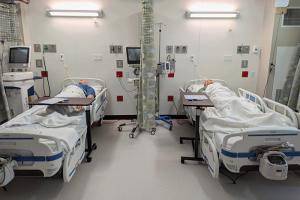Sustainable operations in health care facilities

By integrating sustainability into capital planning, health care organizations can align their operational and financial goals with sustainability objectives.
Image by Getty Images
Sustainability through the lens of health care has several applications, including the executive leadership driving long-term financial sustainability, the environmental services staff maintaining a healthy indoor environment for patients and the workforce, and engineers and technicians overseeing the physical environment and the operation of its systems.
Each of these disciplines considers and applies sustainability differently throughout their daily functions, but a common denominator is how they support the overall mission of health care — to provide the highest-quality care to patients and ensure a safe healing environment.
When professionals in health care facilities management typically think of sustainability, concepts that often emerge first are energy efficiency, project management and utility performance. It is easy to perceive sustainability within these functions as their own silos, unintentionally forming a balancing act when it comes to allocating resources, staff and time.
This begs the question: How can the paradigm of sustainability shift from one of balance to one of integration across teams, departments and the organization as a whole?
Integration versus balance
There are a few key differences between balance and integration. Two of them are boundary management and flexibility.
When integrating sustainability through a project, there is an overlap between those responsible for the progress and implementation of tasks. This ensures that flexibility is prioritized and allows stakeholders to adapt to changes in timelines, funding or personnel. An integrated approach allows project stakeholders to have their voices heard and collaborate on the planning and execution of portions of the project they directly impact.
Balanced sustainability focuses on compartmentalizing project tasks to specific individuals or teams. This allows for more control over the tasks or goals. Think of a relay team, when one person runs their portion of the race and passes the baton to the next team member. It takes every person to do their part to achieve the main goal of winning the race, but it is difficult to jump in and assist a team member when it is not one’s turn within a balanced approach.
A balanced approach to sustainability is linear, while an integrated approach is dynamic. There is no right or wrong method, but by identifying the advantages and disadvantages of each, it helps determine which is the more effective approach when applying it within organizations.
Organizational perspectives
The types of facilities represented within health care organizations include hospitals, ambulatory surgical centers, outpatient clinics, long-term care entities, nursing facilities and urgent care clinics. Each have their own specializations and can be housed under one organizational name. The way sustainability is adopted and implemented can vary from one organization to the next.
In the hundreds of health care systems within the United States, there are many examples of sustainability being implemented through balanced and integrated approaches. The American Society for Health Care Engineering (ASHE) has an extensive network of professionals and state chapter affiliates. A role found in nearly every ASHE Chapter is the sustainability liaison, who has their finger on the pulse when it comes to their membership’s and region’s sustainability affairs.
ASHE sustainability staff tapped into a few of these liaisons’ experiences with polling questions about their organizations. Questions included how they view sustainability overall, how they approach incorporating sustainability into new projects, how they engage stakeholders throughout the course of a project timeline, how they educate staff and how they foster internal support.
The responses varied greatly due to a variety of factors, including the size of the organization and how many full-time equivalent employees (FTEs) they dedicate to specific teams and geographical regions. With the goal of providing a well-rounded overview of perspectives on sustainability, ASHE sustainability staff were able to identify many areas of overlap and common best practices.
The perspectives came from medium-sized hospital systems, academic medical systems and large-scale organizations with nearly 3,000 physical locations that cover a broad range of care. The responses to the question of who or what team has responsibility for handling sustainability and energy efficiency varied largely depending on the size of the organization.
Larger organizations tend to have a team made up of members from facilities, supply chain, clinical, policy and finance departments across the organization. Smaller organizations tend to have one or two sustainability or energy FTEs dedicated to managing their initiatives.
It is important to recognize the impact that the size of an organization has on either their balanced or integrated approach to sustainability. Larger organizations, with entire sustainability teams, have a greater likelihood of utilizing an integrated approach given their increased share of stakeholder participation compared to smaller organizations.
When describing their organization’s views on sustainability, many sustainability liaisons identified financial incentives from state or federal authorities as key motivators. Others were driven by local regulations or organizational missions to support the highest-quality environment for healing.
Additionally, organizations recognized the operational savings opportunities gained from implementing efficiency practices through firsthand experience. For example, hospitals may have seen a reduction in energy costs by installing energy-efficient lighting systems or adopting renewable energy sources.
The catalysts, whether financial, regulatory or experiential, highlight the benefits of implementation. Consequently, each organization acknowledged the financial and operational advantages that came from their initiatives that ultimately contributed to their overall success and sustainability.
Strategic capital planning
Recognizing the importance of sustainability is essential for embedding initiatives into the long-term strategies of health care organizations. Strategic capital planning is a critical part of this process, ensuring that financial resources are allocated to projects to maintain lasting benefits.
Facilities teams are particularly important in this effort. Their expertise in managing building operations and assets allows them to identify areas where sustainability initiatives can be implemented effectively. This gives sustainability and energy efficiency a vital role at the decision-making table, often working closely with engineering, facilities and operations departments.
By integrating sustainability into capital planning, health care organizations can align their operational and financial goals with sustainability objectives. Sustainability teams or individuals are key players in this process. Their responsibilities include identifying potential projects and securing funding, which may come from grants, power purchase agreements or surplus budgets.
Having a say in capital planning allows these teams to ensure that sustainability efforts are strategically woven into the organization’s broader plans. Sustainability projects often involve measures that improve energy efficiency, reduce waste or optimize resource use, all of which can lower expenses over time.
Beyond financial benefits, this process promotes collaboration among various departments, such as facilities, operations and engineering, fostering a culture of sustainability. When multiple teams work together toward shared goals, it creates a unified and cohesive effort that permeates all levels of the organization.
Embedding sustainability into strategic planning is not just about meeting immediate goals. It’s a forward-thinking approach that positions health care organizations to adapt to future challenges, such as rising energy costs or changing regulations.
Proactively incorporating sustainability into capital planning aligns with financial and operational priorities, encourages interdepartmental collaboration and builds a culture of sustainability. This holistic approach not only drives meaningful progress but also sets organizations up for long-term success.
Stakeholders and staff
While looking holistically at the design process, an essential step is synchronization with the project stakeholders. Owners; planning, design and construction teams; and contractors each bring their own expectations and objectives when approaching a new project.
Establishing sustainability as a fundamental pillar in the building owner’s project requirements during the planning stage guides decision-makers to prioritize sustainable practices and outcomes from the start. This ensures that sustainability and energy efficiency is embedded in the project requirements and guides decisions while issuing requests for proposals, selecting bids from vendors and prioritizing funding from the inception of the project.
An easy way to determine whether an organization should use a balanced or integrated approach is to look at the beginning stages of a new project. Is the sustainability team or individual brought in early during the vendor selection, planning and design process, or are they only brought in to collaborate during critical points? When sustainability is baked in throughout the processes of creating and executing a new project, it allows the project teams to be able to pivot and explore alternative options as the inevitable obstacles arise along the project timeline.
Engaging with the sustainability staff early and often in new projects can uncover savings opportunities that can be planned and acted upon. Utilizing their experience aids in identifying potential incentives and strategic partnerships with vendors and utility companies and ensures that those who will be operating and maintaining the systems are intimately familiar with their processes. An additional benefit of continuous coordination with sustainability staff is flexibility when it comes to changing timelines, unforeseen site conditions or value engineering.
To successfully embed sustainability and efficiency into projects, these principles must be embraced organizationwide and remain a priority for staff. However, this can be challenging as daily operations and unexpected urgent tasks often take precedence. Cultivating a sustainable mindset is not something that happens immediately but requires time and consistent effort to establish.
Building this foundation begins with achieving regular successes to demonstrate the tangible benefits of sustainability. Examples include installing energy-efficient lighting; implementing variable-frequency drives; and setting up setback modes for heating, ventilating and air-conditioning systems and thermostats. These small but impactful wins showcase how efficiency measures can save energy, reduce costs and streamline processes.
By highlighting these achievements, staff members gain confidence in sustainability initiatives and are more likely to stay engaged. This ongoing effort motivates teams to continuously seek new opportunities to conserve resources, whether they be financial, supplies or time.
Through steady progress and collaboration, organizations can embed sustainability as a core value, fostering a long-term culture of efficiency and responsibility. This holistic approach not only ensures that sustainability and energy-
efficiency initiatives are seamlessly integrated into the organizational functions but also encourages collaboration and innovation across hospital departments.
Pursuit of sustainability
There are many tools and resources that organizations can draw from to guide their efficiency efforts through benchmarking (see related article below).
Ultimately, the pursuit of sustainability and energy efficiency in health care project management aligns with the mission of providing high-quality care in a safe, compassionate and environmentally responsible manner, ensuring that future generations can continue to benefit from a sustainable health care system.
Related article // Tools and resources to integrate sustainability into an organization
Fully integrating sustainability into the organizational mindset is a gradual process. Just like a tree that needs strong roots to anchor into the soil, sustainability needs to be developed from a solid foundation of knowledge.
The tools and resources developed by the American Society for Health Care Engineering (ASHE), contributing subject matter experts and numerous sustainability task forces equip health care facilities professionals with the skills and information needed to effectively integrate sustainability practices, efficiency measures and discussion topics into their standard operating procedures.
Each organization is on its own path. Some are much farther ahead than others, but there are still many organizations that are just setting out and starting to look for ways that their facilities can be even more efficient stewards of their resources.
The ASHE Sustainability Roadmap for Health Care™ is the first place to look for those interested in pursuing sustainability and efficiency resources. For those early on the journey, there are existing resources such as a sustainability glossary, which defines commonly used sustainability terms and phrases to ensure all stakeholders are using consistent language, and a sustainability guide, which provides facilities managers with step-by-step directions for developing, executing and maintaining an organizational sustainability program.
ASHE’s Energy to Care® Dashboard is a platform for building owners and operators to benchmark the utility performance of their buildings, track the impact of energy-efficiency projects and measure utility cost savings. The dashboard was designed to reduce user burden and can even be linked to the Environmental Protection Agency’s ENERGY STAR® Portfolio Manager to accurately benchmark an organization’s portfolio of buildings.
Additionally, the ASHE energy conversation measures are a set of 52 actionable resources across eight categories that can help integrate sustainable practices into the health care environment. Establishing these efficiency efforts as the standard promotes and engrains the mindset of sustainability across the organization and reinforces the overall mission of health care to provide the highest-quality care to patients and ensure a safe and compassionate healing environment.
For those with an established program, there also are comprehensive resources such as the Electrifying Heat in an Existing Hospital case study publication, which assesses the technical and financial feasibility of electrifying an existing building’s thermal load and offers a deeper dive into the most common emissions sources found in health care operations tied to strategies on how to measure, report and manage them. Tools and resources like these reinforce the basics for the effective management of the health care physical environment.
Whether it is utilizing a platform that helps benchmark a building’s utility portfolio or investigating heating, ventilating and air-conditioning and lighting setbacks allowed in code by room occupancy type, it is finding ways like these to save energy that directly relates to dollars saved with the additional bonus of a reduced operational footprint.
Austin Wallace, MA, SFP, is sustainability senior specialist for the American Society for Health Care Engineering. He can be reached at awallace@aha.org.




